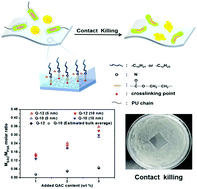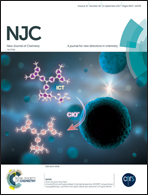Design of polyurethane acrylic antimicrobial films via one-step UV curing
Abstract
We synthesized two reactive quaternary ammonium methacrylate compounds (QAC-10 and QAC-12) bearing hydrophobic tails with different alkyl chain lengths. Cross-linked films with excellent antimicrobial properties were obtained from a mixture of a polyurethane acrylate prepolymer and a reactive QAC via one-step UV curing. The QAC-containing films showed total kill against both Gram-negative Escherichia coli (E. coli) and Gram-positive Staphylococcus epidermidis (S. epidermidis) at QAC-12 concentrations as low as ∼2.5 wt% relative to the polyurethane acrylate prepolymer, which was substantially lower than the QAC amount needed in the films containing QAC-10 with a shorter hydrocarbon tail (C10H21). Compared with the QAC-10-containing films, the higher antimicrobial potency in the QAC-12-containing films was the consequence of the longer hydrophobic alkyl tail (C12H25), which offered a stronger driving force for the surface enrichment of the QAC and, thus, greater surface charge density (the longer tail may also penetrate the cell membrane more easily due to stronger hydrophobic interactions). A zone of inhibition test confirmed that the antimicrobial effect of these films was on the basis of contact killing and there was no leaching of antimicrobial species from the cross-linked films.



 Please wait while we load your content...
Please wait while we load your content...